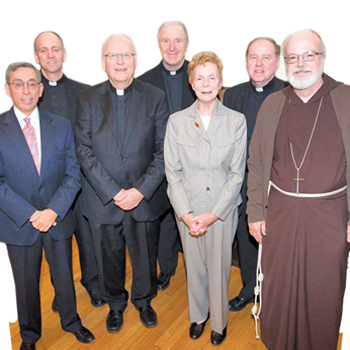Robert E. Cooley is a seasoned veteran of joint ventures, mergers, and other forms of partnership among theological schools. He was named president of Gordon-Conwell Theological Seminary in 1981, just five years after the completion of the consolidation of Gordon Divinity School and Conwell School of Theology — two theological schools that had separated from undergraduate institutions. Among his early duties: fulfilling the complicated terms of separation from Gordon College and assuaging the concerns of J. Howard Pew, the philanthropist who financed the consolidation.
Since his retirement in 1997 from Gordon-Conwell, Cooley has served as an adviser to numerous institutions that have considered some kind of merger, and he’s skeptical about the possibility of success. Most merger studies, he says, do not lead to successful mergers. Of 10 projects he has shepherded, only two resulted in a formal consolidation. And the root of the problem is usually that the missions of the schools are not fully compatible.
In Trust’s editor, Jay Blossom, recently asked Cooley to share some of his insights about cooperation among theological schools.
Motives for cooperation
Let me suggest six reasons as to why a seminary would want to get into a joint venture. I tend not to speak of these as “mergers,” because a merger is only one possibility. I tend to speak of them as either “joint ventures” or “collaboration.” That tends to take some of the sharp edge off of the concept.
- Great opportunities, limited resources. We’re living in a time when there are tremendous opportunities for ministry. The needs are great — for engaged clergy leadership and trained lay leadership. But our resources are limited. One option is to join with others in addressing the church’s needs. Together, schools can sometimes do more than they can alone.
- Strengthening finances. When an institution gets into extreme financial stress, merging is one of the options that boards pursue. But financial crisis is not a valid reason to enter into a joint venture, because it overlooks far more important things, like compatibility of mission.
- Gaining crucial mass. The boards and president of a school with a shrinking enrollment may look at a joint venture.
- Educational excellence. In the blending of faculty and resources, some boards and presidents see the possibility of providing a stronger education.
- Blending constituencies. Where pluralism and multiculturalism are valued, an institution that lacks that kind of multidimensionality may want to join with another school to create a new blend of students. For example, in a joint venture between a smaller Hispanic school and a larger Anglo-European institution, the smaller school might gain a stronger framework to carry on its mission, while the larger institution might increase the multiculturalism of its student body. But pitfalls are possible. The dominant institution may have different values and a different teaching methodology than the smaller. And in a true merger, the smaller institution may lose its sense of autonomy. That’s why I don’t recommend a true merger in cases like this – instead, I recommend other kinds of joint ventures that can enrich a student community.
- Economies of scale. When several universities enter into a partnership agreement on technology, that’s a good example of economies of scale. Seminaries within the same denomination or within the same geographical area may also be able to create similar collaborations. Some boards hope that by partnering with other theological schools — perhaps others within the same denomination — they might be able to eliminate certain redundancies in operational expenses.
I have a bias: I wouldn’t enter into a conversation about joint venture for a negative reason — that’s a takeover. Instead, I like to approach this from a positive standpoint: What can be gained from a joint venture?
Forms of collaboration
What are some of the possible forms of collaboration between theological schools? Let me pick three.
- True merger. One institution merges its assets and program into a larger one, and the smaller institution then loses its identity.
Example: In 1974, the Philadelphia Divinity School merged with the Episcopal Theological Seminary in Cambridge, Massachusetts. The merged school, called Episcopal Divinity School, remained in Cambridge, and the Philadelphia site closed.
- Consolidation. This is where two institutions blend their assets and resources and create a new third institution distinct from either of the predecessor schools.
Example: Gordon Divinity School separated from Gordon College; Conwell School of Theology separated from Temple University. In 1969 the two theological schools began a seven-year process of consolidation that created Gordon-Conwell Theological Seminary.
- Consortium or conglomerate. Without losing their institutional identities, two or more institutions enter a joint venture to address redundancies. They may share teaching or library resources. In more advanced consortia, there may even be joint registration.
Example: The Interdenominational Theological Center comprises six historically African-American seminaries, plus two affiliates. The schools share faculty, administration, and a campus in Atlanta, Georgia, and are accredited as a single institution.
Another variation on the consortium model occurs when one institution outsources its educational function to another.
Example: St. Francis de Sales Seminary in St. Francis, Wisconsin, prepares candidates for the priesthood by offering pastoral, human, and spiritual formation. But intellectual formation is provided by nearby Sacred Heart School of Theology in Hales Corners, Wisconsin, where students travel four days a week for classes.
Reasons collaboration might not work
Joint ventures frequently fail before they get off the ground. Here are several reasons that a proposed collaboration might not work.
- Lack of trust. If you do not trust the various parties, I advise you not to enter into the first conversation. Any joint venture must be built on trust.
- Lack of leadership. If you look at successful collaborations, you see that in each case, the board and president forged strong leadership together. In other words, this is not a topic that’s sent off to a study committee. The collaboration must be on the front burner — the president and the board chair must give visible leadership. If you do not have visible, positive leadership, then it’s going nowhere.
- Incompatible missions and value systems. Unless the missions of the institutions are complementary and there are areas of compatibility, the prospects of success are limited. All theological schools have a particular mission and value system, generally outlined by their founders. It’s hard to blend missions that are incompatible.
- Strong ethos of autonomy. Even if a school is financially weak or has few students, it may retain a strong sense of autonomy. If this dominates its ethos, the school may not be a viable candidate for a joint venture.
- Lack of engagement with stakeholders. If your denominational leaders, alumni, and donors are not on board, there’s going to be a battle. That’s why it’s important not to explore collaborations in a mode of secrecy.
A successful partnership is one in which the focus is on education and not operations. If you’re hoping to join together simply to enhance financial efficiencies, the joint venture is not going to succeed in the long run. You must focus the collaboration on the educational side in order to get faculty ownership of the process.
And there has to be a successful legal and financial audit. The worst thing is to uncover some legal reason why the two institutions cannot be joined — restricted gifts or questions about ownership, for example — late in the game. If restricted covenants and long-term financial obligations are not understood right up at the front, this will undermine the whole process.
A successful joint venture depends upon public information. If two or more boards decide to study a merger or other partnership, they need to announce that fact right up front. All stakeholders need to be informed that a study is underway, and they need to be informed constantly of the progress.




























